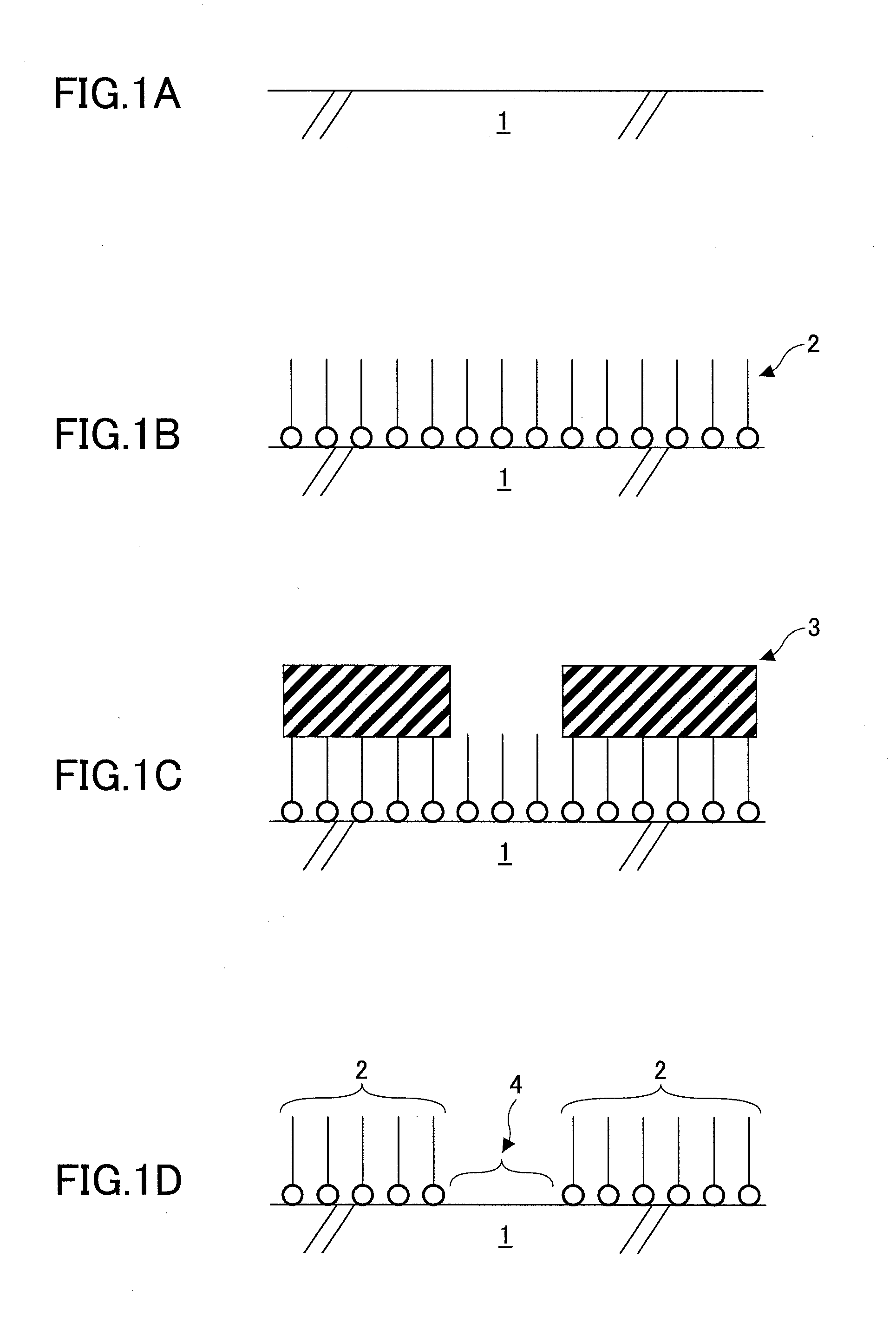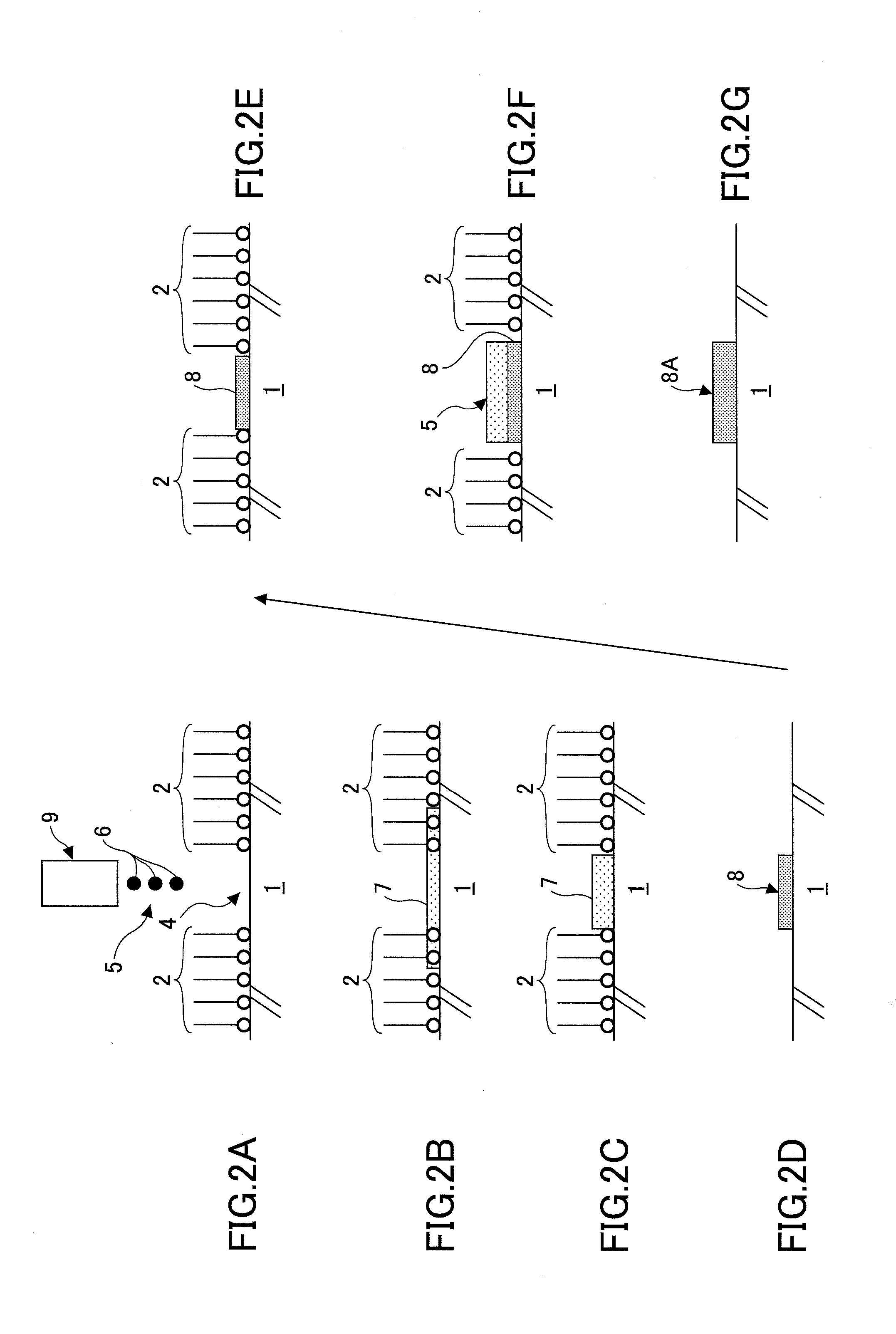Method of forming electromechanical transducer film, electromechanical transducer film, electromechanical transducer element, and liquid discharge head
- Summary
- Abstract
- Description
- Claims
- Application Information
AI Technical Summary
Benefits of technology
Problems solved by technology
Method used
Image
Examples
first embodiment
[0049]Hereinafter, the first embodiment of the method of forming the electromechanical transducer film by the sol-gel method is explained. FIGS. 1A-1D are schematic cross-sectional views illustrating the surface modification process for modifying the portion of the surface of a substrate 1. An electrode formed of platinum (Pt) (not shown) is formed as the first electrode or the lower electrode on the substrate 1 shown in FIG. 1A. FIG. 1B shows a state in which a SAM film 2 is formed on the whole surface of the substrate 1. The SAM film 2 is obtained by causing alkanethiol to be self-assembled by dipping the substrate 1 into an alkanethiol solution. Here, 1-dodecanethiol (CH3(CH2)11SH) is utilized. FIG. 1C shows a state in which photo resist layers 3 are pattern formed by photolithography, so as to remove a portion of the SAM film 2 placed at a position where the PZT precursor film is to be formed, and to protect a necessary portion of the SAM film 2. In the state shown in FIG. 1C, f...
second embodiment
[0055]In a second embodiment, the PZT precursor solution 5 (sol-gel solution) is applied for the second time and after, similar to the method of forming the electromechanical transducer film according to the first embodiment. As it is shown in the example of FIG. 3A in which the PZT precursor solution 5 is applied for the second time, the PZT precursor solution 5 is applied to the substrate 1, so that the liquid droplets 6 of the PZT precursor solution 5 are adhered to specific portions of the desired pattern area (hydrophilic area 4), and that the center of each of the dots of the liquid droplets 6 is adhered to the center of the desired pattern area in the width direction. Here, the specific portions of the desired pattern area are the portions where the liquid droplets 6 have not been adhered to in the first time of the application. The portions of the liquid droplets 6 which have been adhered to the areas outside the desired pattern area are attracted toward inside the desired p...
third embodiment
[0057]In a third embodiment, as a continuation and repetition process of the process of the second embodiment, the substrate 1 was rinsed with isopropyl alcohol and dipped into an alkanethiol solution. In this manner, the SAM film 2 was formed. Since the SAM film 2 was not formed on the oxide film on and after the second time, the pattern of the SAM film 2 was obtained without performing the photolithography process, as shown in FIG. 2E. The contact angle of pure water with respect to the SAM film 2 was 110 degrees, and the contact angle of pure water with respect to the PZT film 8 was 18 degrees. In this state, the target position was aligned to the position of the PZT film 8, which was formed when the application process was performed for the first time, and the PZT precursor solution (sol-gel solution) 5 was applied again to the substrate 1 by the method according to the first embodiment and the second embodiment using the inkjet application device. Similar to the cases of the fi...
PUM
 Login to View More
Login to View More Abstract
Description
Claims
Application Information
 Login to View More
Login to View More - R&D
- Intellectual Property
- Life Sciences
- Materials
- Tech Scout
- Unparalleled Data Quality
- Higher Quality Content
- 60% Fewer Hallucinations
Browse by: Latest US Patents, China's latest patents, Technical Efficacy Thesaurus, Application Domain, Technology Topic, Popular Technical Reports.
© 2025 PatSnap. All rights reserved.Legal|Privacy policy|Modern Slavery Act Transparency Statement|Sitemap|About US| Contact US: help@patsnap.com



